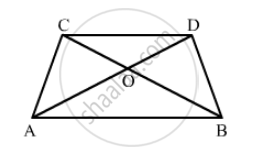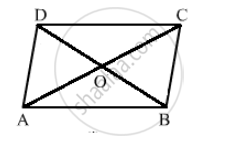Advertisements
Advertisements
प्रश्न
Given below is a parallelogram ABCD. Complete each statement along with the definition or property used.
(i) AD =
(ii) ∠DCB =
(iii) OC =
(iv) ∠DAB + ∠CDA =

उत्तर
The correct figure is

\[(i)\]\[AD = BC (\text{ opposite sides of a parallelogram are equal })\]
\[(ii)\] \[\angle DCB = \angle BAD \left( \text{ opposite angles are equal } \right)\]
\[(iii)\] \[OC = OA \left( \text{ diagonals of a prallelogram bisect each other } \right)\]
\[(iv)\] \[\angle DAB + \angle CDA = 180° \left( \text{ the sum of two adjacent angles of a parallelogram is } {180}^0 \right)\]
APPEARS IN
संबंधित प्रश्न
The measure of one angle of a parallelogram is 70°. What are the measures of the remaining angles?
Which of the following statement is true for a rhombus?
Its diagonals are equal and perpendicular.
Fill in the blank, inthe following, so as to make the statement true:
A rhombus has all its sides of ...... length.
The diagonals of a parallelogram are not perpendicular. Is it a rhombus? Why or why not?
In a rhombus PQRS if PQ = 7.5 cm then find QR. If ∠QPS = 75° then find the measure of ∠PQR and ∠SRQ.
If opposite angles of a rhombus are (2x)° and (3x - 40)° then value of x is ______.
Measure of one angle of a rhombus is 50°, find the measures of remaining three angles.
The lengths of the diagonals of a Rhombus are 12 cm and 16 cm. Find the side of the rhombus
If a diagonal of a quadrilateral bisects both the angles, then it is a ______.
A rhombus is a parallelogram in which ______ sides are equal.
